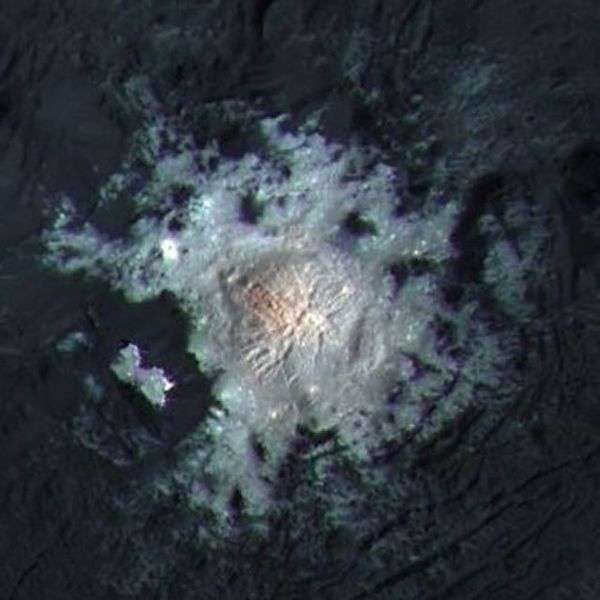Occator (crater)
 Occator imaged by Dawn from LAMO. Fractures are associated with the bright spots and some other areas. | |
| Location | Ceres |
|---|---|
| Coordinates | 19°52′N 238°51′E / 19.86°N 238.85°ECoordinates: 19°52′N 238°51′E / 19.86°N 238.85°E[1][2] |
| Diameter | 92 kilometres (57 mi) |
| Depth | 4 km |
| Naming | After Occator, a helper God of Ceres |
Occator /ɒˈkeɪtər/ is an impact crater located on Ceres that contains "Spot 5", the brightest of the bright spots observed by the Dawn spacecraft. It was known as "Region A" in ground-based images taken by the W. M. Keck Observatory on Mauna Kea.[3]
The crater was named after Occator, the Roman god of the harrow and a helper to Ceres.[1][2]
On 9 December 2015, scientists reported that the bright spots on Ceres, including those in Occator crater, may be related to a type of salt, particularly a form of brine containing magnesium sulfate hexahydrite (MgSO4·6H2O); the spots were also found to be associated with ammonia-rich clays.[4] More recently, on 29 June 2016, scientists reported the bright spot to be mostly sodium carbonate (Na
2CO
3), implying that hydrothermal activity was probably involved in creating the bright spots.[5][6]
The spot in the center of the crater is named Cerealia Facula,[7] and the group of spots to the east is named Vinalia Faculae.[8]
Naming
The name Occator was officially approved by the IAU on 3 July 2015.[9]
Views
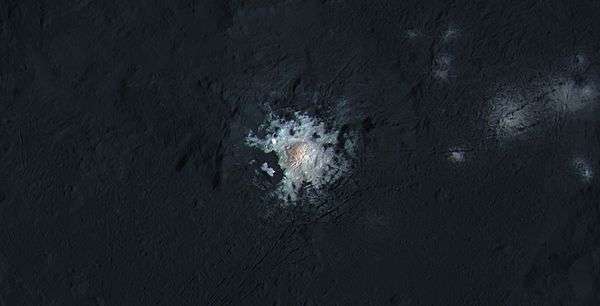
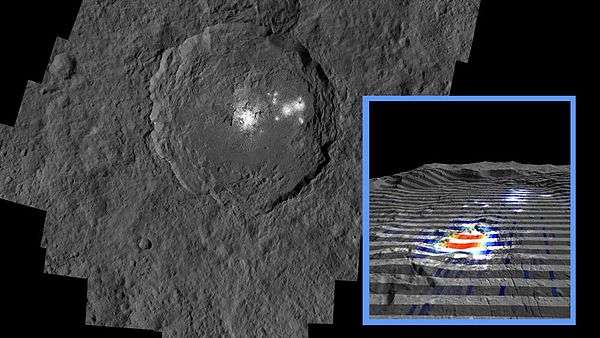

View rendered from
topographic data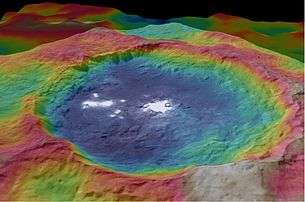
Topographic map
(October 2015)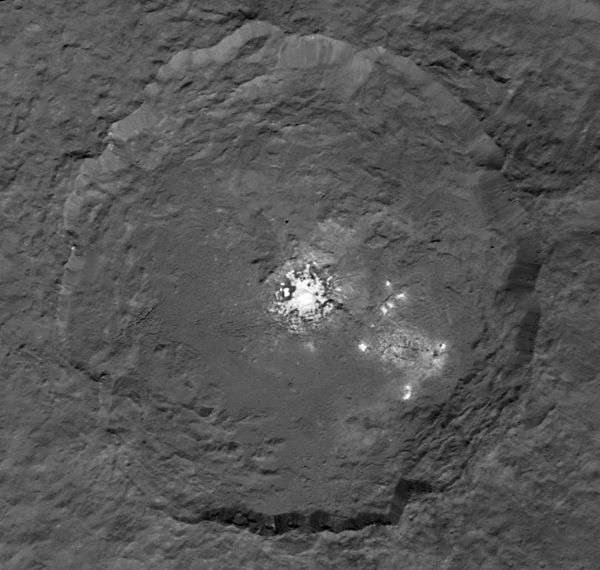
Occator from HAMO. Composite image, so bright spot is not overexposed. 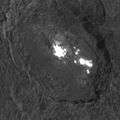
Oblique view
(October 2015)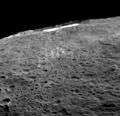
Lateral view
(December 2015)
False colors
(December 2015)
3D-like perspective
(December 2015)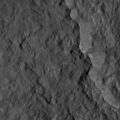
Western rim
(January 2016)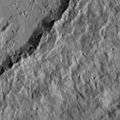
Southeastern rim
(January 2016)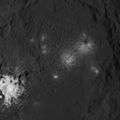
LAMO close-up
(March 2016)
Animations
 4 February 2015; Dawn
4 February 2015; Dawn
90,000 km (56,000 mi) 29 April 2017: Dawn
29 April 2017: Dawn
20,000 km (12,000 mi) 4 May 2015; Dawn
4 May 2015; Dawn
13,600 km (8,500 mi)
(simulated; 01:15; 8 June 2015)[10]
(false colors; 01:12; 9 December 2015)
(color; 03:43; 29 January 2016)
See also
References
- 1 2 Staff (6 July 2015). "Planetary Names: Crater, craters: Occator on Ceres". USGS. Retrieved 16 July 2015.
- 1 2 Staff (13 July 2015). "USGS: Ceres nomenclature" (PDF). USGS. Retrieved 16 July 2015.
- ↑ Kupper; et al. (22 January 2014). "PIA17831: Water Detection on Ceres". NASA. Retrieved 30 July 2015.
- ↑ Landau, Elizabeth (9 December 2015). "New Clues to Ceres' Bright Spots and Origins". NASA. Retrieved 10 December 2015.
- 1 2 Landau, Elizabeth; Greicius, Tony (29 June 2016). "Recent Hydrothermal Activity May Explain Ceres' Brightest Area". NASA. Retrieved 30 June 2016.
- ↑ De Sanctis, M. C.; Raponi, A.; Ammannito, E.; Ciarniello, M.; Toplis, M. J.; McSween, H. Y.; Castillo-Rogez, J. C.; Ehlmann, B. L.; Carrozzo, F. G.; Marchi, S.; Tosi, F.; Zambon, F.; Capaccioni, F.; Capria, M. T.; Fonte, S.; Formisano, M.; Frigeri, A.; Giardino, M.; Longobardo, A.; Magni, G.; Palomba, E.; McFadden, L. A.; Pieters, C. M.; Jaumann, R.; Schenk, P.; Mugnuolo, R.; Raymond, C. A.; Russell, C. T. (2016-06-29). "Bright carbonate deposits as evidence of aqueous alteration on (1) Ceres". Nature. 536: 1–4. PMID 27362221. doi:10.1038/nature18290.
- ↑ "Cerealia Facula". Gazetteer of Planetary Nomenclature. USGS Astrogeology Research Program.
- ↑ "Vinalia Faculae". Gazetteer of Planetary Nomenclature. USGS Astrogeology Research Program.
- ↑ "Occator". planetarynames.
- ↑ Landau, Elizabeth; Dyches, Preston (8 June 2015). "Fly Over Ceres in New Video". NASA. Retrieved 9 June 2015.
